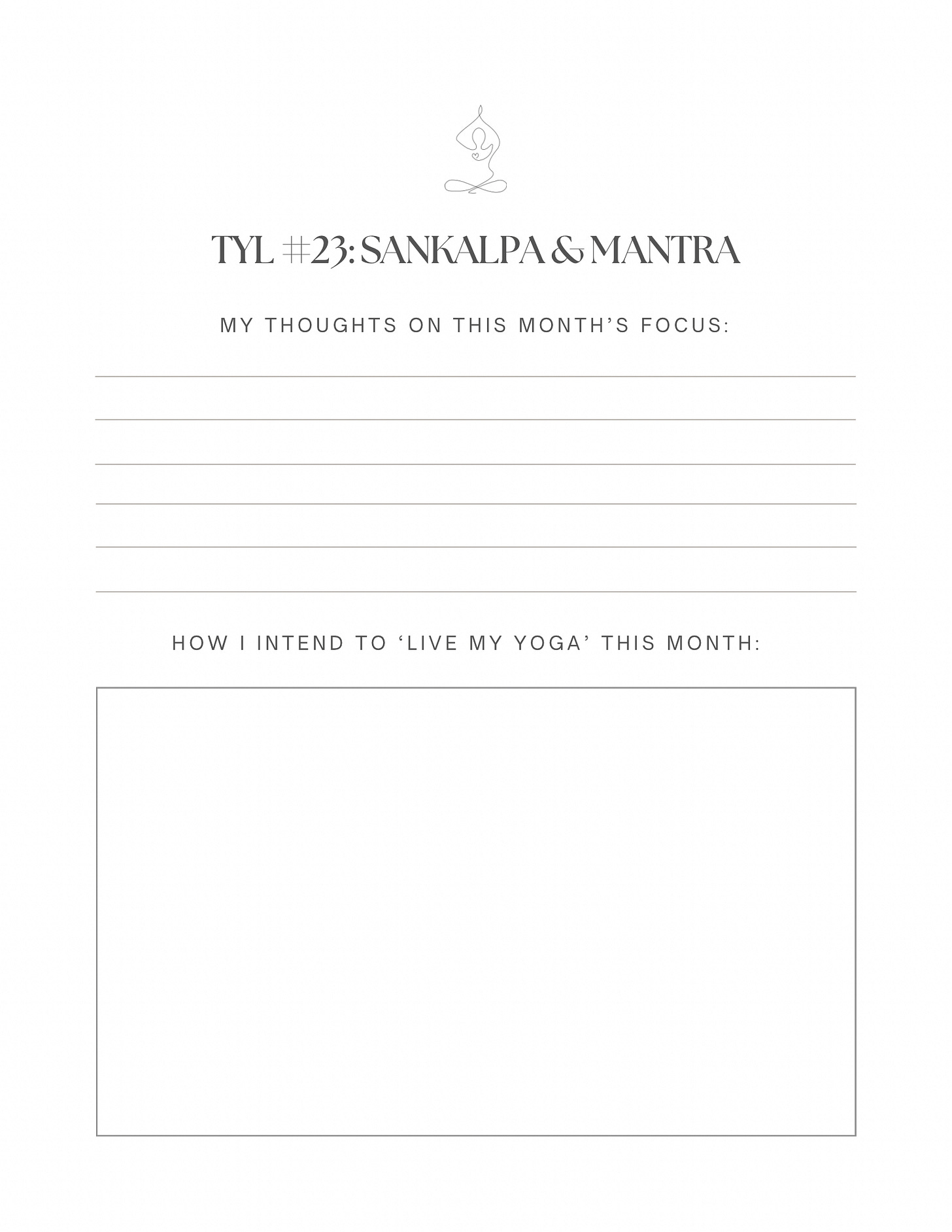#23: Sankalpa & Mantra
“What do you really care about? What pulls you into the here and now, this minute?” Adyashanti
Welcome to #23 of The Yoga Letters.
The first issue of 2024, where are focus will be on living (and breathing) our yoga.
What follows is an introduction to the wonderful practices of mantra and sankalpa, that I hope will serve you well.
But, first, before we go any further: please may I suggest that we step forward slowly and with kindness.
These are troubling times that we are living in, for countless reasons, and so, if you’re a little weary from it all, please know that it is okay; we don’t need to pretend to be brand new and shiny, if we just don’t feel like it.
So, let’s begin, gently… but, before we do, here is a beautiful song that I hope sets the scene for our time here together.
A new year often presents itself to us as the time to set intentions and make changes.
We envisage the year ahead and, perhaps, we have goals that we’d like to achieve.
There is something in the air—a visceral energy created by the growing light since its rebirth at the winter solstice—that propels us forward.
However, as has been said countless times before: we’d be wise to slow down (it is still the middle of winter) and do this work from a place of authenticity.
But I know, first-hand, how hard it is to do so in our world, with its million persuasive ideas about who we should be and how we should live our lives.
Without awareness, we can stumble down a path that isn’t truly our own.
For instance, for me, before I discovered my practices, I, like a lot of people, wrote resolutions on the 1st of January.
Intentional, but chock full of cliches and influenced by shoulds, such as: loose weight, get a better job… blah blah blah.
And, even with yoga in my life, I can still feel the lure of the marketed nonsense and the not-even-mine, such as: aiming for more social media followers (?!?), when I know that is so far removed from what I actually dream of, let alone care about.
I’m not saying there is anything wrong with these aims. But, for me, they were (and are) damaging and incredibly stifling ‘resolutions’.
Luckily, yoga has another offering: the sankalpa.

Guided by this ancient notion, my intentions are now (usually) far away from those hurtful and limiting aims that I used to set - which were essentially based on the notion that I was lacking and inherently not good enough.
If you’ve ever been fortunate to experience yoga Nidra, you may have come across sankalpa before, and you may have your own interpretation of what it means.
But, in simple terms, and as I understand it, a sankalpa is a heartfelt intention.
A Sanskrit word, it can be translated as: ‘san’ = connection with highest truth, and ‘kalpa’ = vow
‘a vow to our higher self’
Born from a deep awareness of our inner wisdom - ignoring what the world may think - a sankalpa is a short conscious statement that encapsulates our soul’s longing.
Set in the present tense, a sankalpa acknowledges (and believes) that we are already everything that we may want or need to be.
To further explain this, here is a video I found that describes the concept rather nicely:
When and how do we set a sankalpa
At some point over this month, I invite you to find a quiet moment to consider what your sankalpa may be.
Perhaps before you got to sleep, or before you get out of bed in the morning - or even during yoga Nidra.
Equally, when doing the washing-up or folding the laundry, or while out on the school-run, if you can, allow yourSelf to come through.
In my experience, the best way to do this is to place both hands at the heart space - one on top of the other - take a few long, slow, deep breaths, and then ask:
What do I need?
What do I want?
And then just listen.
Try not to judge too much.
Write down anything that comes, even if it makes very little sense, or seems ridiculous.
Perhaps use the journal page below to make any notes.
In amongst all of these thoughts and feelings is your true essence. You will know how to distinguish it and which needs and wishes are authentically yours because you’ll be able to feel when something is coming from your heart.
If you have more than one longing, then write them all down. There’s no right or wrong with this stuff.
Whatever arises, trust it.
Then, over the course of the next few weeks, perhaps one (or two) intentions will become the strongest - in terms of your most truthful and heartfelt intention.
If this feels a bit too wide open, and you’d like a firmer boundary in which to consider sankalpa, perhaps stick to your aims for being here, reading TYL, and ask: What are my hopes for my yoga practice this year? What do I need most from this self-enquiry?
Just to be clear, a sankalpa is a concise intention, made in a short, simple statement, expressed in the present tense.
It involves only you, but, usually, is of benefit or in service to others.
For example:
‘I want to do more to help others who are less fortunate’, essentially means: ‘I want to be more compassionate’, and so becomes: ‘I am compassionate’.
Repeat this statement often, quietly and to yourself, making sure it clearly expresses what is most important to you and to how you’d like to feel this coming year.
Fear and insecurity may try to pickle things, and you will know if it is because your statement will fail to resonate with you on a meaningful level. It will instead feel forced.
Many teachers describe looking after your sankalpa as though you are guarding and nurturing a seed. Saying that a sankalpa can take time to cultivate. It’s true: it is not an overnight thing. Just like a tiny plant, it requires our continuous love and attention.

And this is where I want to mention the practice of mantra.
I have written about it before, but to bring it in here is to acknowledge the power of the words we say, to ourselves especially, and in particular when we are talking about our sankalpa.
If you Google Search ‘new year mantra’, you’ll find tons of articles with plenty of suggestions. Or, if you prefer, you can easily find podcasts on the subject.
Conducting your own research may help you to discover a mantra that chimes with your sankalpa.
If, after doing this, you are still unsure of where to start, may I suggest: ‘Sat Nam’.
A simple (but powerful) Gurmukhi mantra, it is not only a seed mantra (and so is perfect for the new year and our intention to nurture our growth) but its meaning is incredibly beautiful: truth in name/essence, or ‘I am truth’.
This is one of the mantras that I will be turning to over these next few weeks, allowing for my heartfelt sankalpa to reveal itself.
I’d really love to know if you have any mantras or affirmations that you find inspiring?
The comments are open to everybody, so please share your wisdom, if you would like to.
But, please, remember that your sankalpa is a precious secret. For you and you alone.
So, please, cherish it.
Guard it.
Keep it safe.
Believe in and nourish it.
This is your only task this month, and please remember to be gentle with yourself; we have plenty of time.
With kindness,
Louisa x
P.S.
Find your #23 journal page below, as well as this month’s playlist.
And if you have any questions at all, feel free to reach out.
From Which It All Began | Bernadette Miller
Tell me, what would you do today if you knew your life to be a celebration of this world?
Would you stop to gather sunlight dropping soundlessly upon pines beyond your window pane?
Would you court dreams too wide for the container of consciousness?
Would you linger in the terrible beauty of uncertainty as if the fullness of the world depended upon your presence?
Would you cast your hopes upon possibilities that abide only in departure?
Would you become the motion of your song, losing itself in over tones of delight or despair
and returning, finally, to the stillness from which it all began?
Further reading and resources:
Yoga Mind by Suzan Colon (read Suzan’s Substack here)
Yoga International: How to create a Sankalpa
Yoga Journal: Sat Nam meaning







I’m new to you and your letters. So glad I found you! I really appreciate your openness, your “we’re in this together” attitude, and yet your willingness to lead the way--A way. Many blessings to you and your Sankalpa for 2024.
Love this. Thank you for sharing and reminding us of the beauty in not only sankalpa, but then connecting it to a mantra. Looking forward to contemplating this more. 😊